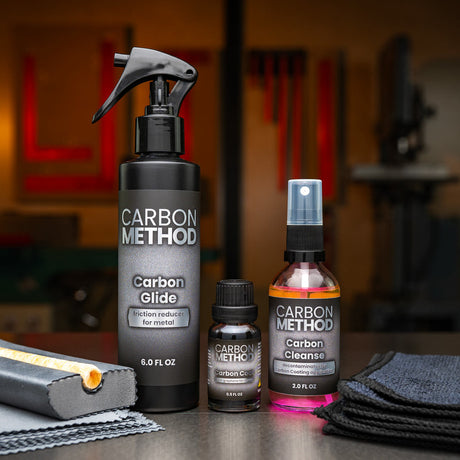Carbon Method
Carbon Method Carbon Coating Quick Kit for 2+ Tools
$176.00$195.00Unit price /UnavailableIn stockCarbon Method
Carbon Method Ceramic Nanofinish Quick Kit for Timber
$225.00$249.90Unit price /UnavailableIn stockCarbon Method
Carbon Method Ceramic Nanofinish Ultimate Kit for Timber
$288.00$319.90Unit price /UnavailableIn stockCarbon Method
Carbon Method Carbon Glide Friction Reducer for Metal 177mL
$35.90$39.90Unit price /UnavailableIn stockCarbon Method
Carbon Method Ceramic Care Maintenance Spray 177ml for Furniture
$34.00$37.90Unit price /UnavailableIn stockCarbon Method
Carbon Method Carbon Coat Buffing Towels Pack of 4
$8.90$9.90Unit price /UnavailableIn stockCarbon Method
Carbon Method Ceramic Nanofinish Buffing Towel Pack of 4
$13.50$14.90Unit price /UnavailableIn stockCarbon Method
Carbon Method Carbon Cleanse Surface Preparation 177mL
$31.50$34.90Unit price /UnavailableIn stockCarbon Method
Carbon Method Reconditioning Oil for Cast Iron Surfaces 58mL
$17.90$19.90Unit price /UnavailableLow stock (6 units)Carbon Method
Carbon Method Carbon Coat Graphene Protection for Metal Surfaces 29.5mL
$126.00$140.50Unit price /UnavailableLow stock (2 units)
Protecting Metal Surfaces in the Workshop with Carbon Method Coatings
Carbon Method products are purpose-built for protecting metal surfaces in woodworking and fabrication workshops. Designed to prevent rust, oxidation, and surface contamination, this system combines surface preparation sprays with high-performance sealants to deliver long-lasting protection without compromising precision or finish quality. Whether you're maintaining a cast iron tablesaw top or preserving hand plane soles, Carbon Method coatings ensure your gear stays clean, rust-free, and ready for use.
At the heart of the system is a multi-step process: cleaning, sealing, and maintaining. The Carbon Method Clean formula removes contaminants such as oils, fingerprints, and existing rust inhibitors that may interfere with bonding. Once the surface is prepped, a thin layer of Seal is applied to create a molecular-level bond with the metal, forming a dry, non-greasy barrier against moisture and air. This protective layer doesn’t attract dust and allows full contact with wood, jigs, and measuring tools.
Unlike traditional waxes or oily rust preventatives, Carbon Method coatings don’t interfere with flatness or dimensional accuracy—making them ideal for machine surfaces like jointer beds, mitre saw fences, and router table tops. The coating cures quickly, requires minimal maintenance, and can be refreshed as needed without buildup. It also provides excellent corrosion protection during storage or in high-humidity environments, including coastal workshops.
Using Carbon Method helps extend the life of expensive tools and machinery while reducing maintenance time. The system is safe for use on bare metal, anodised surfaces, stainless steel, and even high-carbon steel components. For woodworkers seeking a clean, modern alternative to traditional rust prevention methods, Carbon Method offers an effective, workshop-proven solution that protects without compromise.
FAQs
What is Carbon Method used for?
Carbon Method is a protective coating system designed to prevent rust and corrosion on metal surfaces commonly found in woodworking and industrial workshops. It's ideal for tablesaws, hand tools, and precision equipment.
How is it different from traditional rust preventatives like wax?
Unlike waxes or oily coatings, Carbon Method leaves a dry, hard-sealing layer that doesn't attract dust or interfere with flatness and precision. It forms a molecular bond with the metal and doesn’t build up over time.
Can I use Carbon Method on cast iron machine tops?
Yes, it's ideal for protecting cast iron surfaces such as tablesaw tops, jointer beds, and router tables. It prevents oxidation without reducing friction or altering the surface level.
Does Carbon Method affect tool performance?
No. The coating is non-greasy, dust-resistant, and thin enough that it won’t interfere with measurements, sliding jigs, or workpiece contact. It enhances performance by maintaining clean, corrosion-free surfaces.
How long does the protection last?
Under typical workshop conditions, the protective coating lasts several months. In high-humidity environments or coastal areas, it may need reapplication more frequently. Touch-ups are quick and don’t require full re-treatment.
Is it safe to use on hand tools and measuring gear?
Yes, Carbon Method is safe for use on steel, stainless steel, and anodised tools including hand planes, calipers, squares, and marking knives. It protects without affecting accuracy or finish.
Can it be used on stainless or anodised surfaces?
Absolutely. While the main benefit is on ferrous metals prone to rust, Carbon Method coatings also protect stainless steel and anodised aluminium from pitting, staining, and environmental exposure.
What preparation is required before applying Carbon Method?
Begin with Carbon Method Clean to remove oils, dirt, or previous coatings. Then apply the Seal product evenly and allow it to cure as per instructions. Clean surfaces ensure maximum bonding and protection.
Will it affect wood-to-metal contact when using fences or guides?
No, the cured coating is dry and smooth, maintaining excellent contact for workpieces, fences, and jigs. It won’t leave residue on timber or affect glue adhesion during assembly work.












